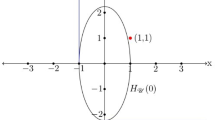Abstract
An equivalence is demonstrated between solving a linear complementarity problem with general data and finding a certain subset of the efficient points of a multiple objective programming problem. A new multiple objective programming based approach to solving linear complementarity problems is presented. Results on existence, uniqueness and computational complexity are included.
Similar content being viewed by others
References
H.P. Benson, “Existence of efficient solutions for vector maximization problems,”Journal of Optimization Theory and Applications 26 (1978) 569–580.
V. Chankong and Y.Y. Haimes,Multiobjective Decision Making—Theory and Methodology (North-Holland, New York, 1983).
A. Charnes and W.W. Cooper, “Goal programming and multiple objective optimization—part 1,”European Journal of Operational Research 1 (1977) 39–54.
S.J. Chung, “NP-completeness of the linear complementarity problem,”Journal of Optimization Theory and Applications 60 (1989) 393–399.
R.W. Cottle and J.S. Pang, “On solving linear complementarity problems as linear programs,”Mathematical Programming Studies 7 (1978) 88–107.
B.C. Eaves, “On quadratic programming,”Management Science 17 (1971a) 698–711.
B.C. Eaves, “The linear complementarity problem,”Management Science 17 (1971b) 612–634.
J.G. Ecker and I.A. Kouada, “Finding efficient points for linear multiple objective programs,”Mathematical Programming 8 (1975) 375–377.
T. Gal, “On efficient sets in vector maximum problems—a brief survey,”European Journal of Operational Research 24 (1986) 253–264.
C.B. Garcia, “Some classes of matrices in linear complementarity theory,”Mathematical Programming 5 (1973) 299–310.
A.M. Geoffrion, “Proper efficiency and the theory of vector maximization,”Journal of Mathematical Analysis and Applications 22 (1968) 618–630.
C.-L. Hwang and A.S.M. Masud,Multiple Objective Decision Making—Methods and Applications (Springer, Berlin, 1979).
J.P. Ignizio,Goal Programming and Extensions (Lexington Books, Lexington, MA, 1976).
M.M. Kostreva, “Block pivot methods for solving the complementarity problem,”Linear Algebra and its Applications 21 (1978) 207–215.
M.M. Kostreva, “Nonconvexity in noncooperative game theory,”International Journal of Game Theory 18 (1989) 247–259.
M.M. Kostreva, T.J. Ordoyne and M. Wiecek, “Multiple objective programming with polynomial objectives and constraints,”European Journal of Operational Research 57 (1992) 381–394.
C.E. Lemke, “Bimatrix equilibrium points and mathematical programming,”Management Science 11 (1965) 681–689.
D.G. Luenberger,Linear and Nonlinear Programming (Addison-Wesley, Reading, MA, 1984).
O.L. Mangasarian, “Linear complementarity problems solvable by a single linear program,”Mathematical Programming 10 (1976) 263–270.
L. Martein, “Lagrange multipliers and generalized differentiable functions in vector extremum problems,”Journal of Optimization Theory and Applications 63 (1989) 281–297.
E.Q.V. Martins, “On a particular quadratic network problem,”European Journal of Operational Research 29 (1987) 317–327.
K.G. Murty,Linear Complementarity, Linear and Nonlinear Programming (Heldermann Verlag, Berlin, 1988).
P.M. Pardalos and J.B. Rosen, “Global optimization approach to the linear complementarity problem,”SIAM Journal of Scientific and Statistical Computing 9 (1988) 341–353.
P.M. Pardalos, “Parallel search algorithms in global optimization,”Applied Mathematics and Computation 29 (1989) 219–229.
R. Rhode and R. Weber, “The range of the efficient frontier in multiple objective linear programming,”Mathematical Programming 28 (1984) 84–95.
D. Solow and P. Sengupta, “A finite descent theory for linear programming, piecewise linear minimization and the linear complementarity problem,”Naval Research Logistics Quarterly 32 (1985) 417–431.
F. Szidarovszky, M.E. Gershon and L. Duckstein,Techniques for Multiobjective Decision Making in Systems Management (Elsevier, Amsterdam, 1986).
R.E. Wendell and D.N. Lee, “Efficiency in multiple objective optimization problems,”Mathematical Programming 12 (1977) 406–414.
L.A. Zadeh, “Optimality and nonscalar-valued performance criteria,”IEEE Transactions on Automatic Control AC-8-1 (1963) 59–60.
Author information
Authors and Affiliations
Rights and permissions
About this article
Cite this article
Kostreva, M.M., Wiecek, M.M. Linear complementarity problems and multiple objective programming. Mathematical Programming 60, 349–359 (1993). https://doi.org/10.1007/BF01580619
Received:
Revised:
Issue Date:
DOI: https://doi.org/10.1007/BF01580619




